| |||||||||||||||||||||||||
ARTBOOK BLOGEventsStore NewsMuseum Stores of the MonthNew Title ReleasesStaff PicksImage GalleryBooks in the MediaExcerpts & EssaysArtbook InterviewsEx LibrisAt First SightThe Artbook | D.A.P. 2025 Gift GuidesArtbook Featured Image ArchiveArtbook D.A.P. Events ArchiveDATE 2/1/2026 Black History Month Reading, 2026DATE 1/22/2026 ICP presents Audrey Sands on 'Lisette Model: The Jazz Pictures'DATE 1/21/2026 Guggenheim Museum presents 'The Future of the Art World' author András Szántó in conversation with Mariët Westermann, Agnieszka Kurant and Souleymane Bachir DiagneDATE 1/19/2026 Rizzoli Bookstore presents Toto Bergamo Rossi, Diane Von Furstenberg and Charles Miers on 'The Gardens of Venice'DATE 1/19/2026 Black Photojournalism, 1945 to 1984DATE 1/18/2026 Artbook at MoMA PS1 presents Paul M. Farber and Sue Mobley launching 'Monument Lab: Re:Generation'DATE 1/17/2026 Artbook at Hauser & Wirth Los Angeles Bookstore presents Peter Tomka on 'Double Player'DATE 1/14/2026 Printed Matter, Inc. presents Pedro Bernstein and Courtney Smith on "Commentary on 'Approximations to the Object'"DATE 1/13/2026 Join us at the Winter Atlanta Gift & Home Market 2026DATE 1/12/2026 Pan-African possibility in 'Ideas of Africa'DATE 1/11/2026 Previously unseen photographs by Canadian color master Fred HerzogDATE 1/5/2026 Minnie Evans’ divine visions of a lost worldDATE 1/1/2026 Happy New Year! | BOOKS IN THE MEDIACORY REYNOLDS | DATE 5/10/2018INTERVIEW with 'Landscape Painting Now' Editor, Todd BradwayIn April, D.A.P. published Landscape Painting Now, a big, bold and deceptively smart global survey of the genre that's been on our bestseller list ever since. We sat down to speak with the book's editor, Todd Bradway, this week to discuss the three-year process of making of the book, painting in general, and his steady rise from scrappy D.A.P. intern in 1994 to one of the most respected art book makers working today.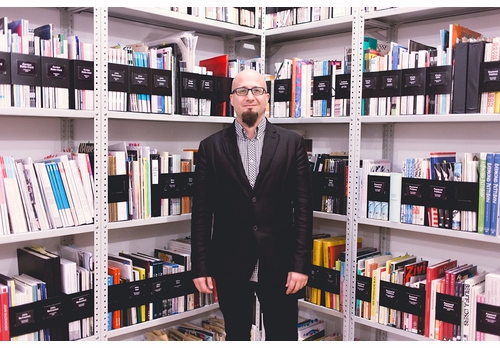 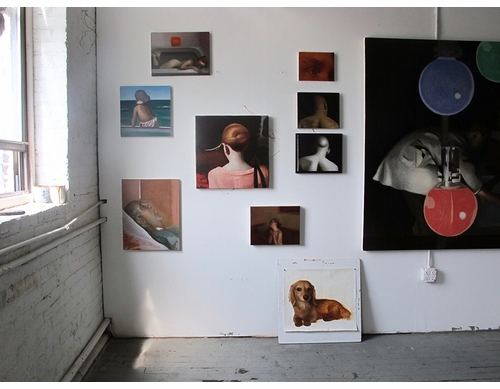 ABOVE: Todd Bradway’s Brooklyn studio, June 2019. TB: Yes, for many years I've maintained a painting studio in Brooklyn and continued to make work throughout my time at D.A.P. and David Zwirner Books, where I worked from 2014–2016. Sometimes my interests have converged. For example, back in 2005 I had the opportunity to edit and produce a monograph on the great painter Vincent Desiderio, one of the most important professors I have had the chance to study with. That was Vincent Desiderio: Paintings 1975-2005, published by D.A.P. and Marlborough Gallery. You also worked on several books on the Spanish figurative painter Antonio López García, whose work is featured in Landscape Painting Now in the section "Realism and Beyond." Some of the other artists in that section include Pat de Groot, Jane Freilicher, Barkley L. Hendricks, April Gornick, Damian Loeb and Richard Estes. The book itself features more than eighty artists, from every generation and all around the world. Tell me how you came up with the concept for this exact book, at this exact time. TB: Landscape Painting Now emerged from a conversation I had with Sharon Gallagher several years ago. We were having lunch and she mentioned that she had an idea for a book on contemporary landscape painting but wasn’t completely sure if there was something there. She had recently bought a house in the country, an old farm house on several acres. Having lived for thirty years in downtown New York, she suddenly had a lot of property to maintain, and was perceiving nature in a very different way. At the same time, she had noticed that there was great demand for landscape painting technique books, but there wasn’t a global survey on the topic. She asked if I would be interested in exploring the idea to see if there was a book to be done. And as a figurative painter and long-time book maker, you were also interested in the genre? TB: Yes. And as it turned out, I'd also noticed, primarily via gallery visits and social media, that a younger generation of painters was working extensively with landscape imagery in a multitude of ways. More established artists whose work I've admired—Mamma Andersson, Rackstraw Downes, Peter Doig, Hernan Bas, Maureen Gallace, Neo Rauch and Alexis Rockman—immediately came to mind, and I could imagine them being pillars on which to build the book’s concept. Once I started the research for the project I could immediately see that there was something there. That part of the process actually ended up taking a year to complete because there were so many fantastic painters to consider. 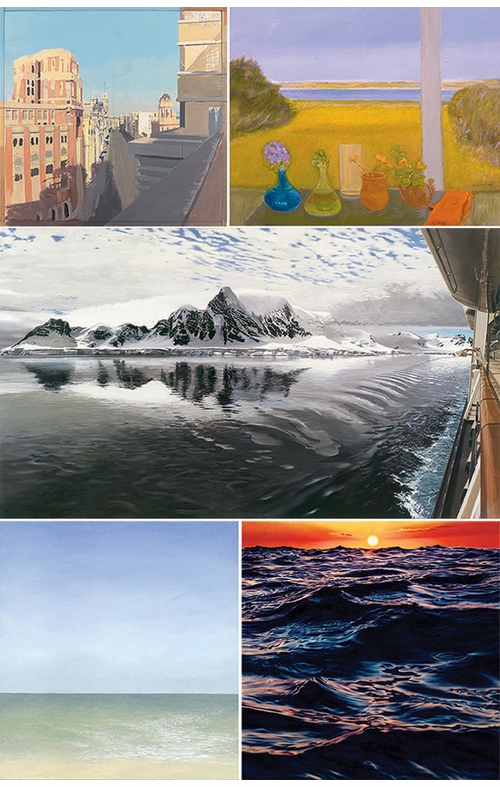 CLOCKWISE FROM TOP LEFT: Antonio López García, "Gran Via, 1 August, 7:15 p.m.," 1990–2011. Courtesy of the artist; Jane Freilicher, "Still Life Before a Window," 2007. Courtesy of Kasmin Gallery; Richard Estes, Antarctica, 2007. Courtesy of Marlborough Gallery; Damian Loeb, "Rayleigh Scattering," 2013. Courtesy of the artist and Acquavella Galleries; Pat de Groot, "spring blue," 2004. Courtesy of Albert Merola Gallery. I can imagine! TB: Honestly, you can never really have enough pages for an ambitious survey like this. However, there were two important criteria that I decided to work within, which helped guide the editorial process. First, that the work needed to be made in the twenty-first century, which allowed us to reinforce the main thesis of the book. Second, that the representation of landscape had to be an ongoing concern throughout the artist's oeuvre. With those guidelines established, I moved forward to determine the final group of artists and the book’s structure. Tell me more about how you arrived at the list of artists. I know you met with Sharon to discuss the list quite a few times. Was it mostly set by the time you invited Barry Schwabsky to write, or did you collaborate? And who came up with the chapter categories: "Realism and Beyond," "Post-Pop Landscapes," "New Romanticism," "Constructed Realities," "Abstracted Topographies" and "Complicated Vistas"? TB: The majority of the artists and the chapter themes were in place before we invited Barry to write for the book. That said, it was a collaborative editorial process from that point forward. Once the research phase was complete, I made the primary selection of artists, which came through a process that was as analytical as it was visual. There was a core group of artists, and then certain paintings that I knew needed to be in the book. I would save the images in folders, while at the same time building out a robust spreadsheet of artists with their personal details, such as birth year and nationality, and typological categories. What were some of the categories you were tracking? TB: I noted whether the work was primarily landscape, seascape or cityscape; the dominant emotional qualities of the work; the types of iconography in the works; art historical qualities; formal characteristics; etc. I would play around with different sorting criteria and come up with various combinations. From there, major groupings of artists were established and I would meet often with Sharon to present my very rough, DIY layouts (my preferred way of working) to make sure they felt right. We would make some tweaks here and there—Sharon’s feedback was especially valuable when it came to the chapter order and the artist order within chapters—and eventually we had the six thematic chapters that you named in the book. The important thing to me was that the organization felt natural, not forced. And I think it does because it came out of this very analytical process. 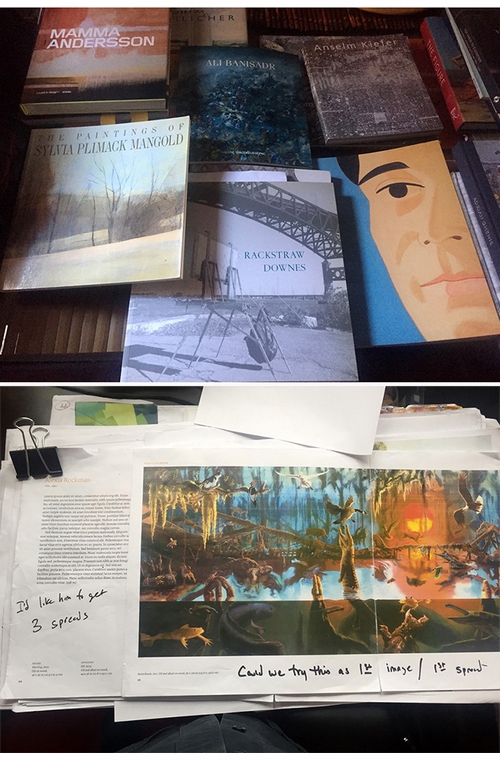 ABOVE, TOP: Reference books used during the research phase of the project. BELOW: Working layouts for Alexis Rockman’s spreads in Landscape Painting Now. Most survey books are organized alphabetically. TB: …Which often feels like a cop out. I definitely didn’t want to go that route. I wanted the book to take a position while also presenting a different, and hopefully interesting, way to consider the work. Once we had the chapters, I went back through all of the research and reconsidered the artists based on those sections. When Barry came on board as the primary author, I presented him my organized selection, figuring we could make revisions based on his feedback. But as it turned out, he fully endorsed the chapters and was pretty excited about the artist selection. He made some excellent suggestions for artists, several of whom I did add to the book, and also some editorial tweaks which I think strengthened the whole. Can you give me an example? TB: One suggestion was to have the chapter "Complicated Vistas" end the book, which I struggled with initially. But in retrospect I definitely think he was right. That section includes Alexis Rockman, Li Dafang, Luc Tuymans, Yishai Jusidman, Serban Savu, Noa Charuvi, Ayman Baalbaki, Liu Xiaodong, Kay Walkingstick, Francis Alÿs, Jordan Nassar and Alfredo & Isabel Aquilizan. Tell me why Barry thought that chapter should end the book, and how you came to see the light. 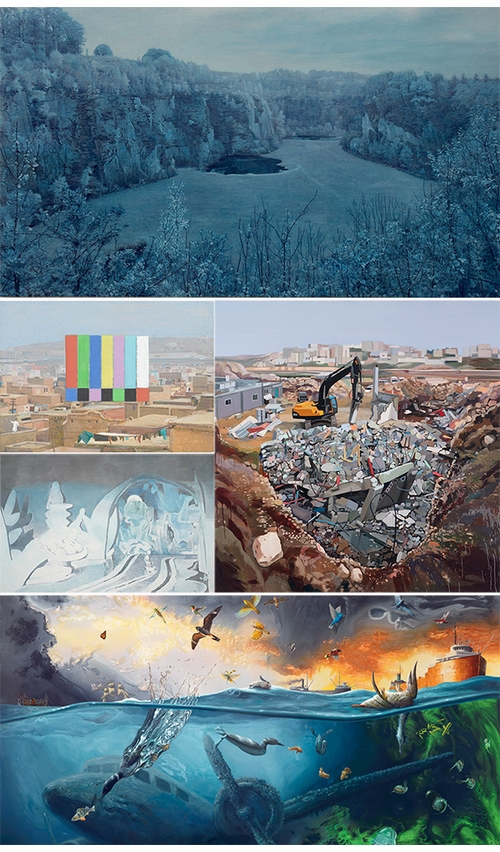 CLOCKWISE FROM TOP LEFT: Yishai Jusidman, "Mauthausen," 2013. Courtesy of the artist; Noa Charuvi, "Hole," 2011. Courtesy of the artist; Alexis Rockman, "Spheres of Influence," 2017. Courtesy of the artist; Luc Tuymans, "Wonderland," 2007. Courtesy of David Zwirner; Francis Alys, "Untitled," 2011–12. Courtesy of David Zwirner. TB: Barry felt strongly that "Complicated Vistas" was where all the other sections conceptually add up—that the other thematic sections had clear roots in the nineteenth and twentieth centuries, whereas the idea of the “complication” is timeless and universal, pointing the genre into the future. The more I considered it, the more I could see that "Complicated Vistas" was a crossroads of sorts and could accommodate artists from any of the other chapters. The section is a culmination of the various modes of expression seen in the preceding chapters, featuring artists who more directly tackle some of the weightier topics through their depiction of the landscape, such as our looming environmental peril, the displacement of populations, and the tensions surrounding lines of demarcation. During the making of the book, were there any artists who surprised you? Who you thought you’d include for sure, but then didn’t fit in somehow? Or who sort of grew on you despite less certain first impressions? TB: Definitely. At a certain point I had compiled a list of about 300 artists to consider—you could make a whole other book with the artists who weren’t included. Several painters who I was pretty convinced about at the very beginning ended up falling out. Others drifted out and then back in. Reasons for this varied, but often it was simply due to the fact that the fabric of the book had shifted. Or it became clear that, at least from my perspective, landscape itself was less of a concern in their particular work. That must have been agonizing, letting go of a painter that you really loved, who didn't fit in for some reason. But on the flip side, you must have made personal discoveries about a few artists along the way. 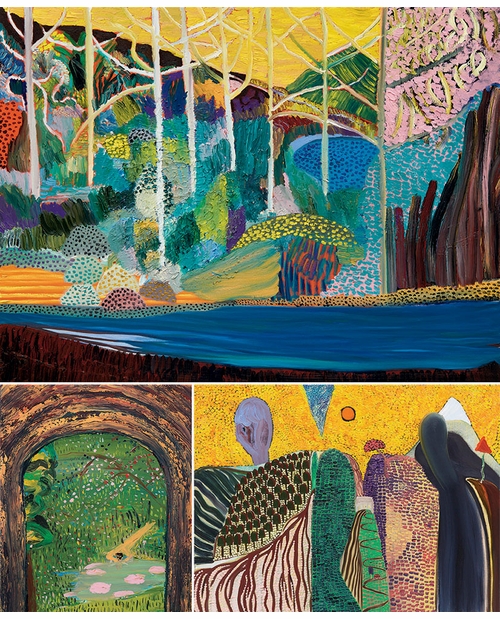 CLOCKWISE FROM TOP LEFT: Matthew Wong, "Morning Landscape," 2017; "The Visit," 2017; "Untitled," 2016. All courtesy of Karma. TB: The research process unfolded over a fairly long period of time, and because the focus was on the art of today, sometimes the information that was publicly available changed as well. For example, when I came across Matthew Wong’s work early in the research, there was very little information about him to be found in print or online, so I just wasn’t sure. I was intrigued by the few images I could find, but I wasn't able to make a clear determination. However, within a year of the start of my research, he was showing with Karma in New York, a monograph had been published, several articles had been written about him and he had developed an active presence on Instagram. (Sadly, he is currently off that platform.) From that point, I was able to get a much better sense of what he was doing and it became crystal clear that he had to be in the book, fitting in perfectly within the chapter on "Post-Pop Landscapes." I guess that's one reason the book feels so fresh. The mix of history and discovery. 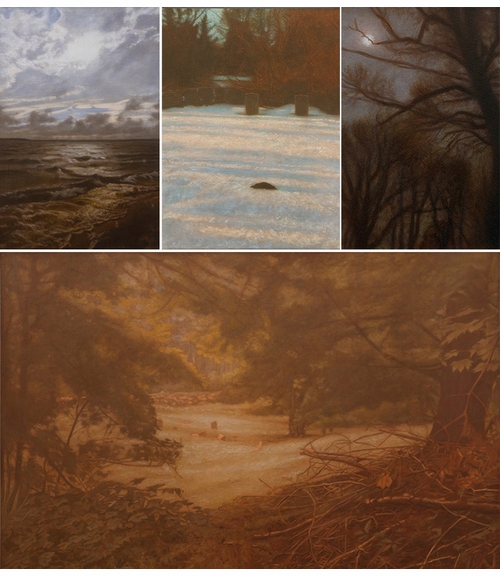 CLOCKWISE FROM TOP LEFT: Matvey Levenstein, "Seascape," 2016; "Winter," 2016; "Untitled," 2016; "Terry Hill in the Summer," 2017. All courtesy of the artist and Kasmin Gallery. TB: That sort of thing happened a few times during the process. Matvey Levenstein was a similar case. I had met him a few years back and knew landscapes were a major focus of his work. But when I started my research for the book, I just couldn’t find much online or in print. He hadn’t shown as much as the other artists in North America, and when I searched online, I mostly found exquisitely crafted interiors and still lifes. When it came time to explore his work in a deeper way, I requested a selection of digital images from his gallery and spoke with him over the phone. That really unlocked my understanding of his practice, and it became clear that not only should he be included, but his work was actually crucial to the chapter, "New Romanticism." He recently had his first exhibition at Kasmin, a brilliant exhibition of paintings, which I think clearly backed that up. Given the fact that you're so in love with painting, can I ask which artist most surprised you, or swept you off your feet? TB: Perhaps the best example would be Lois Dodd. For some reason, I just didn’t know her work as deeply as some of the others when I started out, but she was on my list of artists to research. When Barry came aboard, he included her on a separate list of artists he thought we should consider—he had recently edited an important monograph on her work by Lund Humphries—so I focused my attention on her more squarely, and it became crystal clear that she was essential to the project. Not only should she be in the book, we actually couldn’t publish a book on contemporary landscape painting without her. Since then she has really become one of my favorites. She is a national treasure and I’m glad our book will play a part in bringing her work to a wider audience. I couldn't agree more! Todd, one last question. You're probably working on some top-secret stuff right now, but can you give us a preview of some of the most exciting books that you're working on for the next couple of seasons? 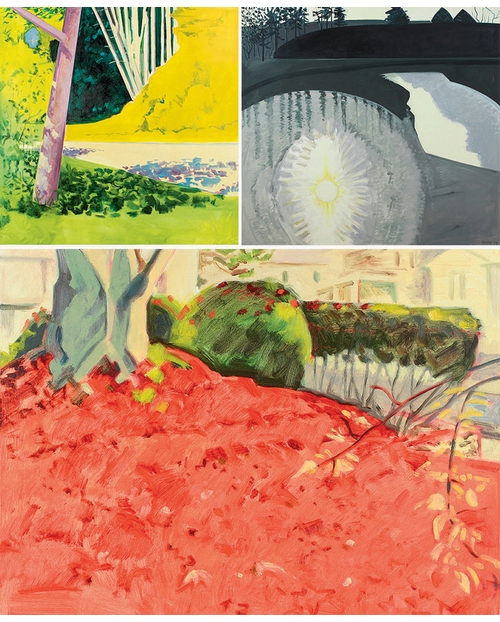 CLOCKWISE FROM TOP LEFT: Lois Dodd, "Barn Door View," 2009; "Winter Sunset, Blair Pond," 2008; "Red Maple," 2008. Courtesy of Alexandre Gallery. TB: Currently I’m collaborating with the painter Michael Kagan on the catalogue for his Virginia Museum of Contemporary Art exhibition, which opens this September. This will be his first museum show and the monograph, which is being designed by Mike Dyer of Remake, includes text contributions by Alison Byrne, Matthew Israel, Bill Powers and Pharrell Wiliams. I’ve also been working closely with Alexis Rockman, who was one of the first successful working artists I met when I first moved to New York, on developing an ambitious, thirty year survey of his works on paper for 2020. This will be the first book to focus on his graphic work, which is an incredibly important—yet perhaps under-known, relative to his paintings—aspect of his oeuvre. Beyond those books, I do have a few ideas for the perfect follow up to Landscape Painting Now—but it's too early to discuss them! |
